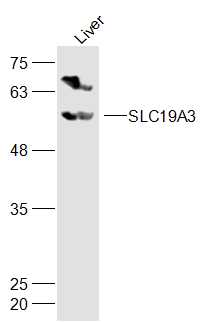
Rabbit Anti-SLC19A3 antibody
Solute carrier family 19 member 3; Thiamine transporter 2; thTr 2; THTR2.
View History [Clear]
Details
Product Name SLC19A3 Chinese Name 溶质载体家族19成员3抗体 Alias Solute carrier family 19 member 3; Thiamine transporter 2; thTr 2; THTR2. Research Area Cell biology Neurobiology Signal transduction Transporter Transmembrane protein Immunogen Species Rabbit Clonality Polyclonal React Species Mouse, (predicted: Human, Rat, ) Applications WB=1:500-2000 ELISA=1:5000-10000 IHC-P=1:100-500 IHC-F=1:100-500 ICC=1:100-500 IF=1:100-500 (Paraffin sections need antigen repair)
not yet tested in other applications.
optimal dilutions/concentrations should be determined by the end user.Theoretical molecular weight 56kDa Cellular localization The cell membrane Form Liquid Concentration 1mg/ml immunogen KLH conjugated synthetic peptide derived from human SLC19A3: 261-360/496 <Extracellular> Lsotype IgG Purification affinity purified by Protein A Buffer Solution Preservative: 15mM Sodium Azide, Constituents: 1% BSA, 0.01M PBS, pH 7.4 Storage Shipped at 4℃. Store at -20 °C for one year. Avoid repeated freeze/thaw cycles. Attention This product as supplied is intended for research use only, not for use in human, therapeutic or diagnostic applications. PubMed PubMed Product Detail This gene encodes a ubiquitously expressed transmembrane thiamine transporter that lacks folate transport activity. Mutations in this gene cause biotin-responsive basal ganglia disease (BBGD); a recessive disorder manifested in childhood that progresses to chronic encephalopathy, dystonia, quadriparesis, and death if untreated. Patients with BBGD have bilateral necrosis in the head of the caudate nucleus and in the putamen. Administration of high doses of biotin in the early progression of the disorder eliminates pathological symptoms while delayed treatment results in residual paraparesis, mild mental retardation, or dystonia. Administration of thiamine is ineffective in the treatment of this disorder. Experiments have failed to show that this protein can transport biotin. Mutations in this gene also cause a Wernicke's-like encephalopathy.[provided by RefSeq, Jan 2010]
Function:
Mediates high affinity thiamine uptake, propably via a proton anti-port mechanism. Has no folate transport activity.
Subcellular Location:
Plasma membrane.
Tissue Specificity:
Widely expressed but most abundant in placenta, kidney and liver.
DISEASE:
The disease is caused by mutations affecting the gene represented in this entry.
Disease description:An autosomal recessive metabolic disorder characterized by episodic encephalopathy, often triggered by febrile illness, presenting as confusion, seizures, external ophthalmoplegia, dysphagia, and sometimes coma and death. If untreated, encephalopathies can result in permanent dystonia. Brain imaging may show characteristic bilateral lesions of the basal ganglia.
Similarity:
Belongs to the reduced folate carrier (RFC) transporter (TC 2.A.48) family.
SWISS:
Q9BZV2
Gene ID:
80704
Database links:Entrez Gene: 80704 Human
Omim: 606152 Human
SwissProt: Q9BZV2 Human
Unigene: 221597 Human
Product Picture
References (0)
No References
Bought notes(bought amounts latest0)
No one bought this product
User Comment(Total0User Comment Num)
- No comment



 +86 571 56623320
+86 571 56623320
 +86 18668110335
+86 18668110335

